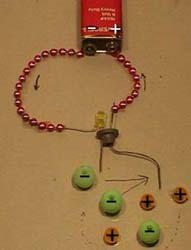 ......
...... .......
.......
Experiment
5
Sea
water conducts electricity,
transforming
sodium chloride (NaCl) into chlorine gas
* Left:
Connect the negative terminal of the battery with the short lead of the
light-emitting
diode (LED).
The positive terminal
is connected to one of the sharpened ends of a pencil stub.
* Dip the long lead of the
LED and the second end of the pencil into a blister
containing 1 ml sea water.
* The LED shines, as sea
water conducts electricity.
* Middle: Gas bubbles
can be seen on both supplies. A smell of chlorine is observed at the pencil
tip.
* Right: This
model visualizes what happens during the experiment with sea water.
A circuit is needed
for electricity to flow. It starts at the negative terminal of the battery:
* Negatively charged particles
called electrons (red tiny beads) are pressed through the white
wire and the LED.
* The long lead of the LED
repels negatively charged chloride particles (Cl-,
green beads).
* These are attracted
by the pencil tip which is connected to the positive terminal of the battery.
* One electron is snatched
away from each negative chloride particle and sucked to the positive
terminal of the battery.
* By losing an electron
a negative chloride particle of sodium chloride is transformed
into an uncharged chlorine particle.
* (You must not yet know
what happens to the positively charged sodium particles (Na+,
yellow beads).
 ......
...... .......
.......